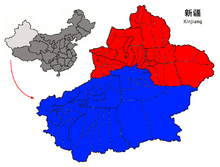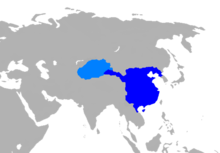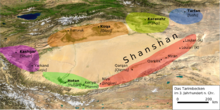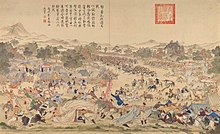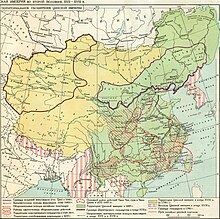A | B | C | D | E | F | G | H | CH | I | J | K | L | M | N | O | P | Q | R | S | T | U | V | W | X | Y | Z | 0 | 1 | 2 | 3 | 4 | 5 | 6 | 7 | 8 | 9
Xinjiang Uygur Autonomous Region | |
|---|---|
| Name transcription(s) | |
| • Chinese | 新疆维吾尔自治区 (Xīnjiāng Wéiwú'ěr Zìzhìqū) |
| • Uyghur | شىنجاڭ ئۇيغۇر ئاپتونوم رايونى (Shinjang Uyghur Aptonom Rayoni) |
| • Abbreviation | XJ / 新 (Xīn) |
Clockwise from top:
| |
 Location of Xinjiang within China | |
| Coordinates: 41°N 85°E / 41°N 85°ECoordinates: 41°N 85°E / 41°N 85°E | |
| Country | China |
| Capital and largest city | Ürümqi |
| Divisions | 14 prefectures, 99 counties, 1005 townships |
| Government | |
| • Type | Autonomous region |
| • Body | Xinjiang Uygur Autonomous Regional People's Congress |
| • CPC Secretary | Ma Xingrui |
| • Congress Chairwoman | Zumret Obul |
| • Government Chairman | Erkin Tuniyaz |
| • CPPCC Chairman | Nurlan Abilmazhinuly |
| Area | |
| • Total | 1,664,897 km2 (642,820 sq mi) |
| • Rank | 1st |
| Highest elevation (Mount K2) | 8,611 m (28,251 ft) |
| Lowest elevation | −154 m (−505 ft) |
| Population | |
| • Total | 25,890,000 |
| • Rank | 21st |
| • Density | 16/km2 (40/sq mi) |
| • Rank | 29th |
| Demographics | |
| • Ethnic composition (2020 Census) | |
| • Languages and dialects | |
| ISO 3166 code | CN-XJ |
| GDP (2021) | CN¥1.6 trillion US$251 billion (25th)[6] |
| GDP per capita | CN¥61,952 US$9,600 (21st) |
| GDP growth | |
| HDI (2019) | 0.732[7] (high) (22nd) |
| Website | www (Xinjiang Uygur Autonomous Region) |
Xinjiang[n 1] (UK: /ˌʃɪndʒiːˈæŋ/,[8] US: /ˈʃɪnˈdʒjɑːŋ/),[9] officially the Xinjiang Uygur Autonomous Region (XUAR),[10] is an autonomous region of the People's Republic of China (PRC), located in the northwest of the country at the crossroads of Central Asia and East Asia. Being the largest province-level division of China by area and the 8th-largest country subdivision in the world, Xinjiang spans over 1.6 million square kilometres (620,000 sq mi) and has about 25 million inhabitants.[1][11] Xinjiang borders the countries of Mongolia, Russia, Kazakhstan, Kyrgyzstan, Tajikistan, Afghanistan, Pakistan and India. The rugged Karakoram, Kunlun and Tian Shan mountain ranges occupy much of Xinjiang's borders, as well as its western and southern regions. The Aksai Chin and Trans-Karakoram Tract regions, both administered by China, are claimed by India. Xinjiang also borders the Tibet Autonomous Region and the provinces of Gansu and Qinghai. The most well-known route of the historic Silk Road ran through the territory from the east to its northwestern border.
Xinjiang is divided into the Dzungarian Basin in the north and the Tarim Basin in the south by a mountain range and only about 9.7% of Xinjiang's land area is fit for human habitation.[12][unreliable source?] It is home to a number of ethnic groups, including the Uyghurs, Kazakhs, Kyrgyz, the Han Chinese, Tibetans, Hui, Chinese Tajiks (Pamiris), Mongols, Russians and Sibe.[13] There are more than a dozen autonomous prefectures and counties for minorities in Xinjiang. Older English-language reference works often refer to the area as Chinese Turkestan,[14][15] East Turkestan[16] and East Turkistan.[17]
With a documented history of at least 2,500 years, a succession of people and empires have vied for control over all or parts of this territory. The territory came under the rule of the Qing dynasty in the 18th century, which was later replaced by the Republic of China. Since 1949 and the Chinese Civil War, it has been part of the People's Republic of China. In 1954, Xinjiang Production and Construction Corps (XPCC) was established to strengthen border defense against the Soviet Union and promote the local economy by settling soldiers into the region.[18] In 1955, Xinjiang was administratively changed from a province into an autonomous region. In recent decades, abundant oil and mineral reserves have been found in Xinjiang and it is currently China's largest natural gas-producing region.
From the 1990s to the 2010s, the East Turkestan independence movement, separatist conflict and the influence of radical Islam have resulted in unrest in the region with occasional terrorist attacks and clashes between separatist and government forces.[19][20] These conflicts prompted the Chinese government to commit a series of ongoing human rights abuses against Uyghurs and other ethnic and religious minorities in the province including, according to some, genocide.[21][22][23]
Names
| Xinjiang | |||||||||||||||||||||||||||||||||||||||||||||||||
|---|---|---|---|---|---|---|---|---|---|---|---|---|---|---|---|---|---|---|---|---|---|---|---|---|---|---|---|---|---|---|---|---|---|---|---|---|---|---|---|---|---|---|---|---|---|---|---|---|---|
 "Xīnjiāng" in Chinese characters | |||||||||||||||||||||||||||||||||||||||||||||||||
| Chinese name | |||||||||||||||||||||||||||||||||||||||||||||||||
| Chinese | 新疆 | ||||||||||||||||||||||||||||||||||||||||||||||||
| Hanyu Pinyin | Xīnjiāng | ||||||||||||||||||||||||||||||||||||||||||||||||
| Postal | Sinkiang | ||||||||||||||||||||||||||||||||||||||||||||||||
| Literal meaning | "New Frontier" | ||||||||||||||||||||||||||||||||||||||||||||||||
| |||||||||||||||||||||||||||||||||||||||||||||||||
| Xinjiang Uygur Autonomous Region | |||||||||||||||||||||||||||||||||||||||||||||||||
| Simplified Chinese | 新疆维吾尔自治区 | ||||||||||||||||||||||||||||||||||||||||||||||||
| Traditional Chinese | 新疆維吾爾自治區 | ||||||||||||||||||||||||||||||||||||||||||||||||
| Hanyu Pinyin | Xīnjiāng Wéiwú'ěr Zìzhìqū | ||||||||||||||||||||||||||||||||||||||||||||||||
| Postal | Sinkiang Uyghur Autonomous Region | ||||||||||||||||||||||||||||||||||||||||||||||||
| |||||||||||||||||||||||||||||||||||||||||||||||||
| Mongolian name | |||||||||||||||||||||||||||||||||||||||||||||||||
| Mongolian Cyrillic | Шиньжян Уйгурын өөртөө засах орон | ||||||||||||||||||||||||||||||||||||||||||||||||
| Mongolian script | ᠰᠢᠨᠵᠢᠶᠠᠩ ᠤᠶᠢᠭᠤᠷ ᠤᠨ ᠥᠪᠡᠷᠲᠡᠭᠡᠨ ᠵᠠᠰᠠᠬᠤ ᠣᠷᠤᠨ | ||||||||||||||||||||||||||||||||||||||||||||||||
| |||||||||||||||||||||||||||||||||||||||||||||||||
| Uyghur name | |||||||||||||||||||||||||||||||||||||||||||||||||
| Uyghur | شىنجاڭ ئۇيغۇر ئاپتونوم رايونى | ||||||||||||||||||||||||||||||||||||||||||||||||
| |||||||||||||||||||||||||||||||||||||||||||||||||
| Manchu name | |||||||||||||||||||||||||||||||||||||||||||||||||
| Manchu script | ᡳᠴᡝ ᠵᡝᠴᡝᠨ ᡠᡳᡤᡠᡵ ᠪᡝᠶᡝ ᡩᠠᠰᠠᠩᡤᠠ ᡤᠣᠯᠣ | ||||||||||||||||||||||||||||||||||||||||||||||||
| Möllendorff | Ice Jecen Uigur beye dasangga golo | ||||||||||||||||||||||||||||||||||||||||||||||||
| Kazakh name | |||||||||||||||||||||||||||||||||||||||||||||||||
| Kazakh | شينجياڭ ۇيعۇر اۆتونوميالى رايونى Shyńjań Uıǵyr aýtonomııalyq aýdany | ||||||||||||||||||||||||||||||||||||||||||||||||
| Kyrgyz name | |||||||||||||||||||||||||||||||||||||||||||||||||
| Kyrgyz | شئنجاڭ ۇيعۇر اپتونوم رايونۇ Шинжаң-Уйгур автоном району Şincañ-Uyğur avtonom rayonu | ||||||||||||||||||||||||||||||||||||||||||||||||
| Oirat name | |||||||||||||||||||||||||||||||||||||||||||||||||
| Oirat | ᠱᡅᠨᡓᡅᡕᠠᡊ ᡇᡕᡅᡎᡇᠷ ᡅᠨ ᡄᡋᡄᠷᡄᡃᠨ ᠴᠠᠰᠠᡍᡇ ᡆᠷᡇᠨ Šinǰiyang Uyiγur-in ebereen zasaqu orun | ||||||||||||||||||||||||||||||||||||||||||||||||
| Xibe name | |||||||||||||||||||||||||||||||||||||||||||||||||
| Xibe | ᠰᡞᠨᡪᠶᠠᡢ ᡠᡞᡤᡠᠷ ᠪᡝᠶᡝ ᡩᠠᠰᠠᡢᡤᠠ ᡤᠣᠯᠣ Sinjyang Uigur beye dasangga golo | ||||||||||||||||||||||||||||||||||||||||||||||||
The general region of Xinjiang has been known by many different names in earlier times, in indigenous languages as well as other languages. These names include Altishahr, the historical Uyghur name for the southern half of the region referring to "the six cities" of the Tarim Basin, as well as Khotan, Khotay, Chinese Tartary, High Tartary, East Chagatay (it was the eastern part of the Chagatai Khanate), Moghulistan ("land of the Mongols"), Kashgaria, Little Bokhara, Serindia (due to Indian cultural influence)[24] and, in Chinese, "Western Regions".[25]
In Chinese, under the Han dynasty, Xinjiang was known as Xiyu (西域), meaning "Western Regions". Between the 2nd century BCE and 2nd century CE the Han Empire established the Protectorate of the Western Regions or Xiyu Protectorate (西域都護府) in an effort to secure the profitable routes of the Silk Road.[26] The Western Regions during the Tang era were known as Qixi (磧西). Qi refers to the Gobi Desert while Xi refers to the west. The Tang Empire had established the Protectorate General to Pacify the West or Anxi Protectorate (安西都護府) in 640 to control the region.
During the Qing dynasty, the northern part of Xinjiang, Dzungaria was known as Zhunbu (準部, "Dzungar region") and the Southern Tarim Basin was known as Huijiang (回疆, "Muslim Frontier"). Both regions merged after Qing dynasty suppressed the Revolt of the Altishahr Khojas in 1759 and became the region of "Xiyu Xinjiang" (Chinese: 西域新疆; lit. 'Western Regions' New Frontier'), later simplified as "Xinjiang" / "Sinkiang" (Chinese: 新疆, Manchu: ᡳᠴᡝ ᠵᡝᠴᡝᠨ, Romanization: ice jecen). The official name was given during the reign of the Guangxu Emperor in 1878.[27] According to Chinese statesman Zuo Zongtang's report to the Guangxu Emperor, Xinjiang means an "old land newly returned" (故土新歸) or the "new old land".[n 2] It can also be translated as “new frontier” or “new territory.”[29] In fact, the term "Xinjiang" was used in many other places conquered, but never were ruled by Chinese empires directly until the gradual Gaitu Guiliu administrative reform, including regions in Southern China.[30] For instance, present-day Jinchuan County in Sichuan was then known as "Jinchuan Xinjiang", Zhaotong in Yunnan was named directly as "Xinjiang", Qiandongnan region, Anshun and Zhenning were named as "Liangyou Xinjiang" etc.[31]
In 1955, Xinjiang Province was renamed "Xinjiang Uygur Autonomous Region". The name that was originally proposed was simply "Xinjiang Autonomous Region" because that was the name for the imperial territory. This proposal was not well-received by Uyghurs in the Communist Party, who found the name colonialist in nature since it meant “new territory." Saifuddin Azizi, the first chairman of Xinjiang, registered his strong objections to the proposed name with Mao Zedong, arguing that "autonomy is not given to mountains and rivers. It is given to particular nationalities." Some Uyghur Communists proposed the name "Tian Shan Uyghur Autonomous Region" instead. The Han Communists in the central government denied the name Xinjiang was colonialist and that the central government could be colonialists both because they were communists and because China was a victim of colonialism. But due to the Uyghur complaints, the administrative region would be named "Xinjiang Uygur Autonomous Region".[32][29]
Uyghur nationalists refer to Xinjiang as "Uyghurstan".[33]
Description

Xinjiang consists of two main geographically, historically and ethnically distinct regions with different historical names, Dzungaria north of the Tianshan Mountains and the Tarim Basin south of the Tianshan Mountains, before Qing China unified them into one political entity called Xinjiang Province in 1884. At the time of the Qing conquest in 1759, Dzungaria was inhabited by steppe dwelling, nomadic Tibetan Buddhist Dzungar people, while the Tarim Basin was inhabited by sedentary, oasis dwelling, Turkic-speaking Muslim farmers, now known as the Uyghur people. They were governed separately until 1884. The native Uyghur name for the Tarim Basin is Altishahr.
The Qing dynasty was well aware of the differences between the former Buddhist Mongol area to the north of the Tian Shan and the Turkic Muslim area south of the Tian Shan and ruled them in separate administrative units at first.[34] However, Qing people began to think of both areas as part of one distinct region called Xinjiang.[35] The very concept of Xinjiang as one distinct geographic identity was created by the Qing. It was originally not the native inhabitants who viewed it that way, but rather the Chinese who held that point of view.[36] During the Qing rule, no sense of "regional identity" was held by ordinary Xinjiang people; rather, Xinjiang's distinct identity was given to the region by the Qing, since it had distinct geography, history and culture, while at the same time it was created by the Chinese, multicultural, settled by Han and Hui and separated from Central Asia for over a century and a half.[37]
In the late 19th century, it was still being proposed by some people that two separate regions be created out of Xinjiang, the area north of the Tianshan and the area south of the Tianshan, while it was being argued over whether to turn Xinjiang into a province.[38]
Xinjiang is a large, sparsely populated area, spanning over 1.6 million km2 (comparable in size to Iran), which takes up about one sixth of the country's territory. Xinjiang borders the Tibet Autonomous Region and India's Leh district in Ladakh to the south, Qinghai and Gansu provinces to the east, Mongolia (Bayan-Ölgii, Govi-Altai and Khovd Provinces) to the east, Russia's Altai Republic to the north and Kazakhstan (Almaty and East Kazakhstan Regions), Kyrgyzstan (Issyk-Kul, Naryn and Osh Regions), Tajikistan's Gorno-Badakhshan Autonomous Region, Afghanistan's Badakhshan Province and Pakistan's Gilgit-Baltistan to the west.
The east-west chain of the Tian Shan separate Dzungaria in the north from the Tarim Basin in the south. Dzungaria is a dry steppe and the Tarim Basin contains the massive Taklamakan Desert, surrounded by oases. In the east is the Turpan Depression. In the west, the Tian Shan split, forming the Ili River valley.
History
Early history
| History of Xinjiang |
|---|
 |
The earliest inhabitants of the region encompassing modern day Xinjiang were genetically of Ancient North Eurasian and Northeast Asian origin, with later geneflow from during the Bronze Age linked to the expansion of early Indo-Europeans. These population dynamics gave rise to a heterogeneous demographic makeup. Iron Age samples from Xinjiang show intensified levels of admixture between Steppe pastoralists and northeast Asians, with northern and eastern Xinjiang showing more affinities with northeast Asians, and southern Xinjiang showing more affinity with central Asians.[39][40]
Between 2009 and 2015, the remains of 92 individuals in the Xiaohe Cemetery were analyzed for Y chromosome and mitochondrial DNA markers. Genetic analyses of the mummies showed that the paternal lineages of the Xiaohe people were of European[41] origin, while the maternal lineages of the early population were diverse, featuring both East Eurasian and West Eurasian lineages, as well as a small number of Indian lineages. Over time, the west Eurasian maternal lineages were gradually replaced by east Eurasian maternal lineages. This implies a pattern of outmarriage to women from Siberian communities, which, over many hundreds of years, led to the loss of the original diversity of mtDNA lineages observed in the earlier Xiaohe population.[42][43][44]
The Tarim population was therefore always notably diverse, reflecting a complex history of admixture between people of Ancient North Eurasian, South Asian and Northeast Asian descent. The Tarim mummies have been found in various locations in the Western Tarim Basin such as Loulan, the Xiaohe Tomb complex and Qäwrighul. These mummies have been previously suggested to have been Tocharian or Indo-European speakers, but recent evidence suggest that the earliest mummies belonged to a distinct population unrelated to Indo-European pastoralists and spoke an unknown language, probably a language isolate.[45]
Although many of the Tarim mummies were classified as Caucasoid by anthropologists, Tarim Basin sites also contain both "Caucasoid" and "Mongoloid" remains, indicating contact between newly arrived western nomads and agricultural communities in the east.[46] Mummies have been found in various locations in the Western Tarim Basin such as Loulan, the Xiaohe Tomb complex and Qäwrighul. The earliest of the mummies have been previously suggested to have been Tocharian or Indo-European speakers, but recent evidence suggest that the earliest mummies belonged to a distinct population unrelated to Indo-European pastoralists and spoke an unknown language, probably a language isolate.[45]
Nomadic tribes such as the Yuezhi, Saka and Wusun were probably part of the migration of Indo-European speakers who had settled in Western Central Asia long before the Xiongnu and Han Chinese. By the time the Han dynasty under Emperor Wu (r. 141–87 BC) wrested the western Tarim Basin away from its previous overlords (the Xiongnu), it was inhabited by various peoples who included the Indo-European-speaking Tocharians in Turfan and Kucha, the Saka peoples centered in the Shule Kingdom and the Kingdom of Khotan, the various Tibeto-Burmese groups (especially people related to the Qiang) as well as the Han Chinese people.[47] Some linguists posit that the Tocharian language had high amounts of influence from Paleosiberian languages,[48] such as Uralic and Yeniseian languages.
Yuezhi culture is documented in the region. The first known reference to the Yuezhi was in 645 BC by the Chinese chancellor Guan Zhong in his work, Guanzi (管子, Guanzi Essays: 73: 78: 80: 81). He described the Yúshì, 禺氏 (or Niúshì, 牛氏), as a people from the north-west who supplied jade to the Chinese from the nearby mountains (also known as Yushi) in Gansu.[49] The longtime jade supply[50] from the Tarim Basin is well-documented archaeologically: "It is well known that ancient Chinese rulers had a strong attachment to jade. All of the jade items excavated from the tomb of Fuhao of the Shang dynasty, more than 750 pieces, were from Khotan in modern Xinjiang. As early as the mid-first millennium BC, the Yuezhi engaged in the jade trade, of which the major consumers were the rulers of agricultural China."[51]
Crossed by the Northern Silk Road,[52] the Tarim and Dzungaria regions were known as the Western Regions. At the beginning of the Han dynasty (206 BC – 220 AD) the region was ruled by the Xiongnu, a powerful nomadic people based in present-day Mongolia. During the 2nd century BC, the Han dynasty prepared for war against Xiongnu when Emperor Wu of Han dispatched Zhang Qian to explore the mysterious kingdoms to the west and form an alliance with the Yuezhi against the Xiongnu. As a result of the war, the Chinese controlled the strategic region from the Ordos and Gansu corridor to Lop Nor. They separated the Xiongnu from the Qiang people on the south and gained direct access to the Western Regions. Han China sent Zhang Qian as an envoy to the states of the region, beginning several decades of struggle between the Xiongnu and Han China in which China eventually prevailed. In 60 BC, Han China established the Protectorate of the Western Regions (西域都護府) at Wulei (烏壘, near modern Luntai), to oversee the region as far west as the Pamir Mountains. The protectorate was seized during the civil war against Wang Mang (r. AD 9–23), returning to Han control in 91 due to the efforts of general Ban Chao.
The Western Jin dynasty succumbed to successive waves of invasions by nomads from the north at the beginning of the 4th century. The short-lived kingdoms that ruled northwestern China one after the other, including Former Liang, Former Qin, Later Liang and Western Liáng, all attempted to maintain the protectorate, with varying degrees of success. After the final reunification of Northern China under the Northern Wei empire, its protectorate controlled what is now the southeastern region of Xinjiang. Local states such as Shule, Yutian, Guizi and Qiemo controlled the western region, while the central region around Turpan was controlled by Gaochang, remnants of a state (Northern Liang) that once ruled part of what is now Gansu province in northwestern China.
During the Tang dynasty, a series of expeditions were conducted against the Western Turkic Khaganate and their vassals: the oasis states of southern Xinjiang.[53] Campaigns against the oasis states began under Emperor Taizong with the annexation of Gaochang in 640.[54] The nearby kingdom of Karasahr was captured by the Tang in 644 and the kingdom of Kucha was conquered in 649.[55] The Tang Dynasty then established the Protectorate General to Pacify the West (安西都護府) or Anxi Protectorate, in 640 to control the region.
During the Anshi Rebellion, which nearly destroyed the Tang dynasty, Tibet invaded the Tang on a broad front from Xinjiang to Yunnan. It occupied the Tang capital of Chang'an in 763 for 16 days, and controlled southern Xinjiang by the end of the century. The Uyghur Khaganate took control of Northern Xinjiang, much of Central Asia and Mongolia at the same time.
As Tibet and the Uyghur Khaganate declined in the mid-9th century, the Kara-Khanid Khanate (a confederation of Turkic tribes including the Karluks, Chigils and Yaghmas)[56] controlled Western Xinjiang during the 10th and 11th centuries. After the Uyghur Khaganate in Mongolia was destroyed by the Kirghiz in 840, branches of the Uyghurs established themselves in Qocha (Karakhoja) and Beshbalik (near present-day Turfan and Ürümqi). The Uyghur state remained in eastern Xinjiang until the 13th century, although it was ruled by foreign overlords. The Kara-Khanids converted to Islam. The Uyghur state in Eastern Xinjiang, initially Manichean, later converted to Buddhism.
Remnants of the Liao dynasty from Manchuria entered Xinjiang in 1132, fleeing rebellion by the neighboring Jurchens. They established a new empire, the Qara Khitai, which ruled the Kara-Khanid and Uyghur-held parts of the Tarim Basin for the next century. Although Khitan and Chinese were the primary administrative languages, Persian and Uyghur were also used.[57]
Islamization
| Part of a series on Islam in China |
|---|
 |
|
|
Present-day Xinjiang consisted of the Tarim Basin and Dzungaria and was originally inhabited by Indo-European Tocharians and Iranian Sakas who practiced Buddhism and Zoroastrianism. The Turfan and Tarim Basins were inhabited by speakers of Tocharian languages,[58] with Caucasian mummies found in the region.[59] The area became Islamified during the 10th century with the conversion of the Kara-Khanid Khanate, who occupied Kashgar. During the mid-10th century, the Saka Buddhist Kingdom of Khotan was attacked by the Turkic Muslim Karakhanid ruler Musa; the Karakhanid leader Yusuf Qadir Khan conquered Khotan around 1006.[60]
Mongol period
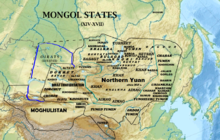
After Genghis Khan unified Mongolia and began his advance west the Uyghur state in the Turpan-Urumchi region offered its allegiance to the Mongols in 1209, contributing taxes and troops to the Mongol imperial effort. In return, the Uyghur rulers retained control of their kingdom; Genghis Khan's Mongol Empire conquered the Qara Khitai in 1218. Xinjiang was a stronghold of Ögedei Khan and later came under the control of his descendant, Kaidu. This branch of the Mongol family kept the Yuan dynasty at bay until their rule ended.
During the Mongol Empire era the Yuan dynasty vied with the Chagatai Khanate for rule of the region and the latter controlled most of it. After the Chagatai Khanate divided into smaller khanates during the mid-14th century, the politically-fractured region was ruled by a number of Persianized Mongol Khans, including those from Moghulistan (with the assistance of local Dughlat emirs), Uigurstan (later Turpan) and Kashgaria. These leaders warred with each other and the Timurids of Transoxiana to the west and the Oirats to the east: the successor Chagatai regime based in Mongolia and China. During the 17th century, the Dzungars established an empire over much of the region.
The Mongolian Dzungars were the collective identity of several Oirat tribes which formed and maintained, one of the last nomadic empires. The Dzungar Khanate covered Dzungaria, extending from the western Great Wall of China to present-day Eastern Kazakhstan and from present-day Northern Kyrgyzstan to Southern Siberia. Most of the region was renamed "Xinjiang" by the Chinese after the fall of the Dzungar Empire, which existed from the early 17th to the mid-18th century.[61]
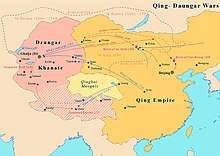
The sedentary Turkic Muslims of the Tarim Basin were originally ruled by the Chagatai Khanate and the nomadic Buddhist Oirat Mongols in Dzungaria ruled the Dzungar Khanate. The Naqshbandi Sufi Khojas, descendants of Muhammad, had replaced the Chagatayid Khans as rulers of the Tarim Basin during the early 17th century. There was a struggle between two Khoja factions: the Afaqi (White Mountain) and the Ishaqi (Black Mountain). The Ishaqi defeated the Afaqi and the Afaq Khoja invited the 5th Dalai Lama (the leader of the Tibetans) to intervene on his behalf in 1677. The Dalai Lama then called on his Dzungar Buddhist followers in the Dzungar Khanate to act on the invitation. The Dzungar Khanate conquered the Tarim Basin in 1680, setting up the Afaqi Khoja as their puppet ruler. After converting to Islam, the descendants of the previously-Buddhist Uyghurs in Turfan believed that the "infidel Kalmuks" (Dzungars) built Buddhist monuments in their region.[62]
Qing dynasty

The Turkic Muslims of the Turfan and Kumul oases then submitted to the Qing dynasty and asked China to free them from the Dzungars; the Qing accepted their rulers as vassals. They warred against the Dzungars for decades before defeating them; Qing Manchu Bannermen then conducted the Dzungar genocide, nearly eradicating them and depopulating Dzungaria. The Qing freed the Afaqi Khoja leader Burhan-ud-din and his brother, Khoja Jihan, from Dzungar imprisonment and appointed them to rule the Tarim Basin as Qing vassals. The Khoja brothers reneged on the agreement, declaring themselves independent leaders of the Tarim Basin. The Qing and the Turfan leader Emin Khoja crushed their revolt, and by 1759 China controlled Dzungaria and the Tarim Basin.
The Manchu Qing dynasty gained control of eastern Xinjiang as a result of a long struggle with the Dzungars which began during the 17th century. In 1755, with the help of the Oirat noble Amursana, the Qing attacked Ghulja and captured the Dzungar khan. After Amursana's request to be declared Dzungar khan went unanswered, he led a revolt against the Qing. Qing armies destroyed the remnants of the Dzungar Khanate over the next two years, and many Han Chinese and Hui moved into the pacified areas.[63]
The native Dzungar Oirat Mongols suffered greatly from the brutal campaigns and a simultaneous smallpox epidemic. Writer Wei Yuan described the resulting desolation in present-day northern Xinjiang as "an empty plain for several thousand li, with no Oirat yurt except those surrendered."[64] It has been estimated that 80 percent of the 600,000 (or more) Dzungars died from a combination of disease and warfare,[65] and recovery took generations.[66]
Han and Hui merchants were initially only allowed to trade in the Tarim Basin; their settlement in the Tarim Basin was banned until the 1830 Muhammad Yusuf Khoja invasion, when the Qing rewarded merchants for fighting off Khoja by allowing them to settle in the basin.[67] The Uyghur Muslim Sayyid and Naqshbandi Sufi rebel of the Afaqi suborder, Jahangir Khoja was sliced to death (Lingchi) in 1828 by the Manchus for leading a rebellion against the Qing. According to Robert Montgomery Martin, many Chinese with a variety of occupations were settled in Dzungaria in 1870; in Turkestan (the Tarim Basin), however, only a few Chinese merchants and garrison soldiers were interspersed with the Muslim population.[68]
The 1765 Ush rebellion by the Uyghurs against the Manchu began after Uyghur women were raped by the servants and son of Manchu official Su-cheng.[69] It was said that "Ush Muslims had long wanted to sleep on Sucheng and son's hides and eat their flesh" because of the months-long abuse.[70] The Manchu emperor ordered the massacre of the Uyghur rebel town; Qing forces enslaved the Uyghur children and women, and killed the Uyghur men.[71] Sexual abuse of Uyghur women by Manchu soldiers and officials triggered deep Uyghur hostility against Manchu rule.[72]
Yettisharedit

By the 1860s, Xinjiang had been under Qing rule for a century. The region was captured in 1759 from the Dzungar Khanate,[73] whose population (the Oirats) became the targets of genocide. Xinjiang was primarily semi-arid or desert and unattractive to non-trading Han settlers, and others (including the Uyghurs) settled there.
The Dungan Revolt by the Muslim Hui and other Muslim ethnic groups was fought in China's Shaanxi, Ningxia and Gansu provinces and in Xinjiang from 1862 to 1877. The conflict led to a reported 20.77 million deaths due to migration and war, with many refugees dying of starvation.[74][failed verification] Thousands of Muslim refugees from Shaanxi fled to Gansu; some formed battalions in eastern Gansu, intending to reconquer their lands in Shaanxi. While the Hui rebels were preparing to attack Gansu and Shaanxi, Yaqub Beg (an Uzbek or Tajik commander of the Kokand Khanate) fled from the khanate in 1865 after losing Tashkent to the Russians. Beg settled in Kashgar, and soon controlled Xinjiang. Although he encouraged trade, built caravansareis, canals and other irrigation systems, his regime was considered harsh. The Chinese took decisive action against Yettishar; an army under General Zuo Zongtang rapidly approached Kashgaria, reconquering it on 16 May 1877.[75]
After reconquering Xinjiang in the late 1870s from Yaqub Beg,[76] the Qing dynasty established Xinjiang ("new frontier") as a province in 1884[77] – making it part of China, and dropping the old names of Zhunbu (準部, Dzungar Region) and Huijiang (Muslimland).[78][79]
After Xinjiang became a Chinese province, the Qing government encouraged the Uyghurs to migrate from southern Xinjiang to other areas of the province (such as the region between Qitai and the capital, largely inhabited by Han Chinese, and Ürümqi, Tacheng (Tabarghatai), Yili, Jinghe, Kur Kara Usu, Ruoqiang, Lop Nor and the lower Tarim River.[80]
Republic of Chinaedit
In 1912, the Qing dynasty was replaced by the Republic of China. Yuan Dahua, the last Qing governor of Xinjiang, fled. One of his subordinates, Yang Zengxin, took control of the province and acceded in name to the Republic of China in March of that year. Balancing mixed ethnic constituencies, Yang controlled Xinjiang until his 1928 assassination after the Northern Expedition of the Kuomintang.[81]
The Kumul Rebellion and others broke out throughout Xinjiang during the early 1930s against Jin Shuren, Yang's successor, involving Uyghurs, other Turkic groups and Hui (Muslim) Chinese. Jin enlisted White Russians to crush the revolts. In the Kashgar region on 12 November 1933, the short-lived First East Turkestan Republic was self-proclaimed after debate about whether it should be called "East Turkestan" or "Uyghuristan".[82][83] The region claimed by the ETR encompassed the Kashgar, Khotan and Aksu Prefectures in southwestern Xinjiang.[84] The Chinese Muslim Kuomintang 36th Division (National Revolutionary Army) defeated the army of the First East Turkestan Republic in the 1934 Battle of Kashgar, ending the republic after Chinese Muslims executed its two emirs: Abdullah Bughra and Nur Ahmad Jan Bughra. The Soviet Union invaded the province; it was brought under the control of northeast Han warlord Sheng Shicai after the 1937 Xinjiang War. Sheng ruled Xinjiang for the next decade with support from the Soviet Union, many of whose ethnic and security policies he instituted. The Soviet Union maintained a military base in the province and deployed several military and economic advisors. Sheng invited a group of Chinese Communists to Xinjiang (including Mao Zedong's brother, Mao Zemin), but executed them all in 1943 in fear of a conspiracy. In 1944, President and Premier of China Chiang Kai-shek, informed by the Soviet Union of Shicai's intention to join it, transferred him to Chongqing as the Minister of Agriculture and Forestry the following year.[85] During the Ili Rebellion, the Soviet Union backed Uyghur separatists to form the Second East Turkestan Republic (2nd ETR) in the Ili region while most of Xinjiang remained under Kuomintang control.[82]
People's Republic of Chinaedit
The People's Liberation Army entered Xinjiang in 1949, when Kuomintang commander Tao Zhiyue and government chairman Burhan Shahidi surrendered the province to them.[83] Five ETR leaders who were to negotiate with the Chinese about ETR sovereignty died in an air crash that year in the Kazakh Soviet Socialist Republic.[86]
The PRC autonomous region was established on 1 October 1955, replacing the province;[83] that year (the first modern census in China was taken in 1953), Uyghurs were 73 percent of Xinjiang's total population of 5.11 million.[32] Although Xinjiang was designated a "Uygur Autonomous Region" since 1954, more than 50 percent of its area is designated autonomous areas for 13 native non-Uyghur groups.[87] Modern Uyghurs developed ethnogenesis in 1955, when the PRC recognized formerly separately self-identified oasis peoples.[88] In the 1950s General Wang Zhen coerced thousands of Hunanese women into sexual servitude at PLA units in Xinjiang.[89]
Southern Xinjiang is home to most of the Uyghur population, about nine million people, out of a total population of twenty million; fifty-five percent of the Han population, mainly urban, live in northern Xinjiang.[90][91] This created an economic imbalance, since the northern Junghar basin (Dzungaria) is more developed than the south.[92]
In 1980, China allowed the United States to establish electronic listening stations in Xinjiang so the United States could monitor Soviet rocket launches in central Asia in exchange for the United States authorizing the sale of dual-use civilian and military technology and nonlethal military equipment to China.[93]
Since Chinese economic reform since the late 1970s has exacerbated uneven regional development, more Uyghurs have migrated to Xinjiang's cities and some Han have migrated to Xinjiang for economic advancement. Chinese leader Deng Xiaoping made a nine-day visit to Xinjiang in 1981 and described the region as "unsteady".[94] Increased ethnic contact and labor competition coincided with Uyghur terrorism since the 1990s, such as the 1997 Ürümqi bus bombings.[95]
In 2000, Uyghurs were 45 percent of Xinjiang's population and 13 percent of Ürümqi's population. With nine percent of Xinjiang's population, Ürümqi accounts for 25 percent of the region's GDP; many rural Uyghurs have migrated to the city for work in its light, heavy and petrochemical industries.[96] Han in Xinjiang are older, better-educated and work in higher-paying professions than their Uyghur counterparts. Han are more likely to cite business reasons for moving to Ürümqi, while some Uyghurs cite legal trouble at home and family reasons for moving to the city.[97] Han and Uyghurs are equally represented in Ürümqi's floating population, which works primarily in commerce. Auto-segregation in the city is widespread in residential concentration, employment relationships and endogamy.[98] In 2010, Uyghurs were a majority in the Tarim Basin and a plurality in Xinjiang as a whole.[99]
Xinjiang has 81 public libraries and 23 museums, compared to none in 1949. It has 98 newspapers in 44 languages, compared with four in 1952. According to official statistics, the ratio of doctors, medical workers, clinics and hospital beds to the general population surpasses the national average; the immunization rate has reached 85 percent.[100]
The ongoing Xinjiang conflict[101][102] includes the 2007 Xinjiang raid,[103] a thwarted 2008 suicide-bombing attempt on a China Southern Airlines flight,[104] the 2008 Kashgar attack which killed 16 police officers four days before the Beijing Olympics,[105][106] the August 2009 syringe attacks,[107] the 2011 Hotan attack,[108] the 2014 Kunming attack,[109] the April 2014 Ürümqi attack,[110] and the May 2014 Ürümqi attack.[111] Several of the attacks were orchestrated by the Turkistan Islamic Party (formerly the East Turkestan Islamic Movement), identified as a terrorist group by several entities (including Russia,[112] Turkey,[113][114] the United Kingdom,[115] the United States until October 2020,[116][117] and the United Nations).[118]
In 2014, Chinese Communist Party (CCP) leadership in Xinjiang commenced a People's War against the "Three Evil Forces" of separatism, terrorism, and extremism. They deployed two hundred thousand party cadres to Xinjiang and the launched the Civil Servant-Family Pair Up program. Chinese Communist Party leader Xi Jinping was dissatisfied with the initial results of the People's War and replaced Zhang Chunxian with Chen Quanguo as Party Committee Secretary in 2016. Following his appointment Chen oversaw the recruitment of tens of thousands of additional police officers and the division of society into three categories: trusted, average, untrustworthy. He instructed his subordinated to "Take this crackdown as the top project," and "to preëmpt the enemy, to strike at the outset." Following a meeting with Xi in Beijing Chen Quanguo held a rally in Ürümqi with ten thousand troops, helicopters, and armored vehicles. As they paraded he announced a "smashing, obliterating offensive," and declared that they would "bury the corpses of terrorists and terror gangs in the vast sea of the People's War."[119]
Chinese authorities have operated internment camps to indoctrinate Uyghurs and other Muslims as part of the People's War since at least 2017.[120][21] The camps have been criticized by a number of countries and human-rights organizations for abuse and mistreatment, with some alleging Uyghur genocide.[121] In 2020, CCP General Secretary Xi Jinping said: "Practice has proven that the party's strategy for governing Xinjiang in the new era is completely correct."[122]
In 2021, authorities sentenced Sattar Sawut - the former head of Xinjiang's education department and author of a Uyghur-language textbook used in Xinjiang since the mid 2000s - to death with a two-year reprieve. The textbook had been created and approved by relevant government officials, but the Associated Press reported in 2021 that Chinese government said that the "2003 and 2009 editions of the textbooks contained 84 passages preaching ethnic separatism, violence, terrorism and religious extremism and that several people were inspired by the books to participate in a bloody anti-government riot in the regional capital Urumqi in 2009." Shirzat Bawudun, the former head of the Xinjiang department of justice, received the same sentence.[123][124] Three other educators and two textbook editors were given lesser sentences.[125] Chen was replaced as Community Party Secretary for Xinjiang by Ma Xingrui in December 2021.[126]
Administrative divisionsedit
Xinjiang is divided into thirteen prefecture-level divisions: four prefecture-level cities, six prefectures and five autonomous prefectures (including the sub-provincial autonomous prefecture of Ili, which in turn has two of the seven prefectures within its jurisdiction) for Mongol, Kazakh, Kyrgyz and Hui minorities. At the end of the year 2017, the total population of Xinjiang was 24.45 million.[127]
These are then divided into 13 districts, 25 county-level cities, 62 counties and 6 autonomous counties. Ten of the county-level cities do not belong to any prefecture and are de facto administered by the Xinjiang Production and Construction Corps. Sub-level divisions of the Xinjiang Uygur Autonomous Region is shown in the adjacent picture and described in the table below:
| Administrative divisions of Xinjiang | ||||||||
|---|---|---|---|---|---|---|---|---|

█ XPCC / Bingtuan administered
county-level divisions █ Subordinate to Ili Kazakh A.P.
☐ Disputed areas claimed by India
and administered by China (see Sino-Indian border dispute) | ||||||||
| Division code[128] | Division | Area in km2[129] | Population 2010[130] | Seat | Divisions[131] | |||
| Districts | Counties | Aut. counties | CL cities | |||||
| 650000 | Xinjiang Uygur Autonomous Region | 1664900.00 | 21,813,334 | Ürümqi city | 13 | 61 | 6 | 27 |
| 650100 | Ürümqi city | 13787.90 | 3,110,280 | Tianshan District | 7 | 1 | ||
| 650200 | Karamay city | 8654.08 | 391,008 | Karamay District | 4 | |||
| 650400 | Turpan city | 67562.91 | 622,679 | Gaochang District | 1 | 2 | ||
| 650500 | Hami city | 142094.88 | 572,400 | Yizhou District | 1 | 1 | 1 | |
| 652300 | Zdroj:https://en.wikipedia.org?pojem=Sinkiang||||||||





